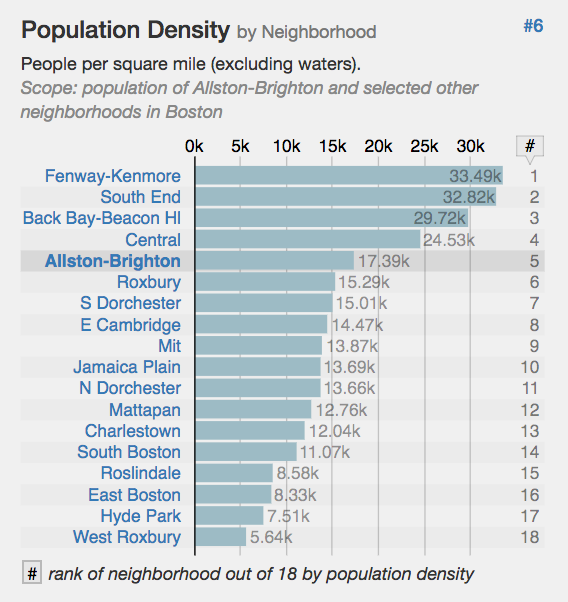Ballooning population in Allston-Brighton
30 views
Skip to first unread message
Eva Webster
Feb 13, 2018, 7:34:42 AM2/13/18
to Homeowners Union of Allston-Brighton, AllstonBrighton2006, Cleveland-Cir...@googlegroups.com
I attended a BPDA public meeting last night for 81 Chestnut Hill Ave., where someone proclaimed that Allston-Brighton has about 20,000 residents (I think the person was trying to make a point that we don’t need to worry about density).
The 20,000 number was complete nonsense, so I stated that A-B’s population is 65,000 at a minimum, and most likely 70,000+ by now, and about to go even higher with many large buildings in the pipeline.
But another resident (a friend and neighborhood activist), thought he new better, and said that A-B has about 50,000 residents. No one stood by my numbers — so it became clear to me that folks simply have no idea how many people live in A-B.
Here is the proof that I was right (I know I shouldn’t be gloating – but how am I otherwise supposed to get any respect ;-)

That’s right — we’re at the 75,000 person mark (and very likely even higher right now), which makes us No. 1 in Boston according to this chart (since for some reason the chart splits Dorchester in two neighborhoods, South and North; if Dorchester was listed as a single neighborhood, we would be No. 2).
(Note: I’m not sure why the chart includes East Cambridge and the MIT area; it’s probably because it reflects a larger census tract that is the basis of this chart.)
When all anticipated developments in North Allston-Brighton, elsewhere in Allston, and along Washington St. and Comm. Ave. in Brighton, get built, the number of residents will easily reach 80,000 (within the span of just several years). If you add Beacon Yards to that, plus some projects we haven’t even heard of yet, we may become equal in size to a town/city of 100,000 people — a DOUBLING of the population in just a few decades.
Below is another chart, one that shows population density (# of people per square mile). You will notice that only downtown neighborhoods (incl. Fenway/Kenmore) are more densely populated than A-B — and all other Boston neighborhoods are less dense (and most of them, significantly less dense) than we are. And with so many large buildings in the pipeline, our density is certain to go higher.

So an inescapable question comes to mind: Why is Allston-Brighton expected to absorb so many large, dense projects (which cumulatively will paralyze traffic on many key roads), while other neighborhoods seem to continue to enjoy less density and fewer development pressures?
I think that finding data/charts showing homeownership rates and average voter turnout in municipal elections per 1,000 residents in each non-downtown Boston neighborhood would shed some light on that. So another question that comes to mind is, what do we do about it?
This is the source of the two charts above:
Fwd: Population of Allston-Brighton, Boston, Massachusetts (Neighborhood) - Statistical Atlas
Joanne D'Alcomo
Feb 13, 2018, 3:27:11 PM2/13/18
to AllstonBrighton2006
A city of Boston document establishes that by 2010, the population of Allston-Brighton was nearly 75,000. (74,997). See attached page from document prepared by Boston’s Department of Neighborhood Development. And now that we are eight years later, the population certainly hasn’t decreased!
Joanne D’Alcomo
Reply all
Reply to author
Forward
0 new messages
